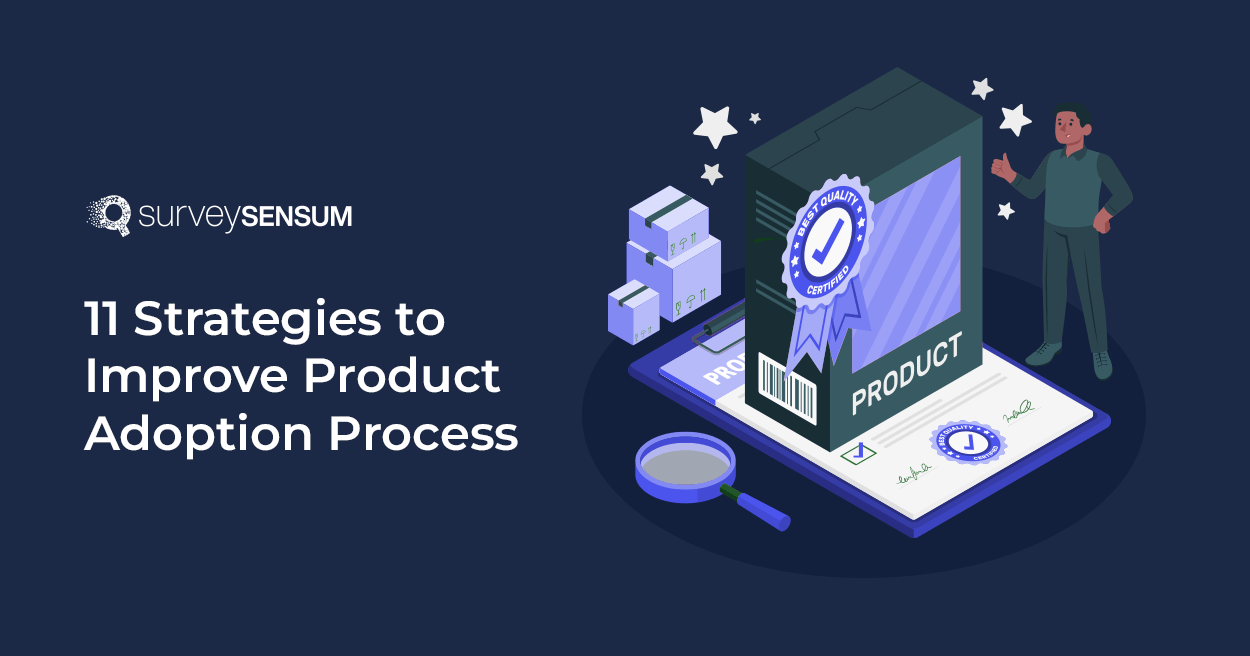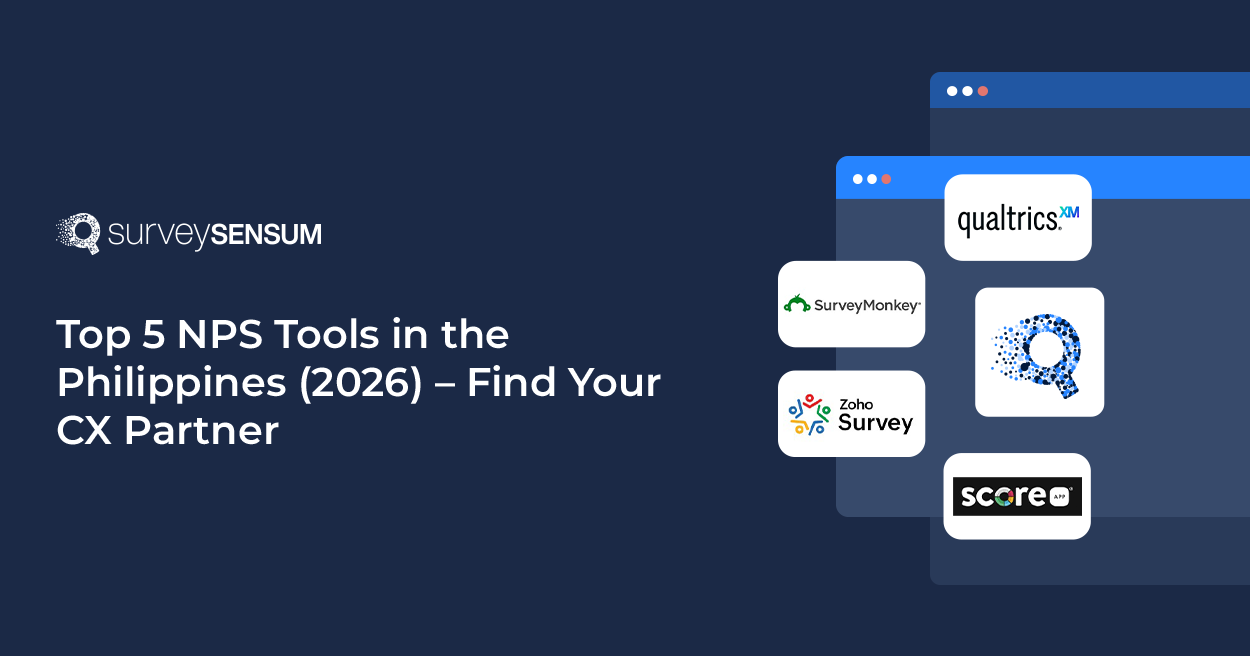

customer lifetime value Have you ever poured your heart and soul into creating a product, only to find that it languishes in the market, struggling to gain traction? As a product manager, this can be a disheartening experience. You’ve likely encountered the pain points of low product adoption and felt the weight of challenges like customer churn and stagnant growth.
In the competitive world of SaaS, the battle for customer retention and product adoption can be fierce. But fear not, for there is hope!
The key to improving product adoption lies in understanding your users better than anyone else. Your SaaS customer feedback platform acts as a bridge, connecting you directly to the voices of your customers. It allows you to listen to their concerns, suggestions, and frustrations and provides a platform for them to express their needs and desires.
In this blog, we’re going to unveil 11 proven strategies that product managers can employ to turn the tide in their favor. These strategies not only tackle the challenges of SaaS platform overload and SaaS customer retention but also promise to enhance overall product adoption.
But before jumping into strategies let’s first understand what product adoption is.
What is Product Adoption?
Product adoption refers to the process a customer goes through from when they first become aware of your product to when they finally find value in it.
It is a critical metric for companies as it directly impacts the success and sustainability of a product. High adoption rates indicate that users are finding value and that the product is effectively meeting their needs.
Now, that we know how important product adoption is, here are some strategies to improve product adoption.
Why Do We Care So Much About Product Adoption?
Product adoption is essential for the long-term success of a business. Here are some detailed reasons why you need to care about your product adoption:
1. Revenue Growth: Higher adoption rates lead to increased sales and recurring revenue, which are critical for the financial health and growth of a company.
2. Customer Retention: Effective product adoption helps retain customers by ensuring they see value in the product, thereby reducing churn rates and increasing customer lifetime value.
3. Market Penetration: Successful adoption can lead to a larger market share as more users integrate the product into their daily routines, making it a preferred choice over competitors.
4. Brand Loyalty and Advocacy: Satisfied users who have successfully adopted the product are more likely to become brand advocates, promoting the product through word-of-mouth and recommendations, which can drive new customer acquisition at a lower cost.
5. Product Improvement: Understanding the adoption process allows companies to gather crucial feedback, which can be used to refine and improve the product, making it more user-friendly and aligned with customer needs.
6. Competitive Advantage: High adoption rates demonstrate a product’s market relevance and superiority, helping a company to stay ahead of competitors and attract more investors and partners. This visibility makes it easier to attract top investors, who bring not only funding but also strategic expertise and connections to help scale the business.
7. Operational Efficiency: As more users adopt the product, companies can achieve economies of scale, optimizing their operations and reducing costs associated with customer support and training.
8. Innovation and Development: Insights gained from the adoption process can drive innovation, helping companies to develop new features and products that meet evolving customer needs and market trends.
Is your product struggling to gain traction in the competitive SaaS market? SurveySensum is here to help! Launch your surveys today!
Well, now that you know all about the importance of product adoption for a business, let’s jump to know the strategies that you can adopt to enhance the same.
11 Proven Strategies to Improve Product Adoption
1. Create an Unforgettable First-Time User Experience
Did you know that 88% of online users are less likely to return after a bad user experience?
This staggering number indicates the importance of creating an exceptional experience for your customers in the initial stages of their journey. If your customer’s initial interaction is positive then it can build a positive impression, establish trust, and set the stage for continued product adoption.
So, here’s how you can ensure that your first-time users have a positive experience:
- Focus on smooth value-based onboarding. Don’t drag your onboarding process by asking for unnecessary details. Keep it short, simple, and easy. Understand your customer’s goals and create a personalized onboarding process tailored to their goals.
- Engage with your users. Create welcome messages, in-app tutorials, or tooltips to guide users through your app/website and create a clear path of value for them.
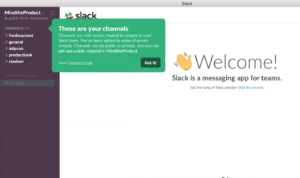
For example, when you create a new account on Slack, it guides you through its different features, highlighting the functionality of each of them.
- Make the product easy to use. Invest in UI and UX design services to ensure your product is intuitive and user-friendly. Keep in mind that complicated navigation and design will only lead to confusion and customer churn.
- Make sure they realize the value early. Highlight the most valuable features of your product during onboarding. Explain how these features address users’ pain points or fulfill their needs in the early stages.
By focusing on your user experience, especially for first-time users, businesses can create an unforgettable experience for their customers and capture their attention from the early stages.
2. Know Your Users
In any business endeavor, one of the fundamental and crucial steps is understanding your customers. This knowledge enables you to identify their needs, preferences, and pain points, which in turn allows you to develop and offer products tailored to their specific requirements. Understanding your users also enables you to attract more of them. By aligning keyword strategy with audience segments and intent, SaaS SEO ensures your product is discoverable by people actively searching for solutions like yours.
Here’s how you can do it effectively to improve product adoption.
- Create detailed profiles of your ideal customers for personalized marketing and messaging. Segment your user base based on demographics, pain points, and goals.
- During the product demos and sales calls with potential customers, ask open-ended questions to understand what they expect from your product. Address their concerns and provide solutions. Moreover, adopt a cobrowsing strategy to guide customers through different stages, from understanding the product demos to completing account setup.
- Use in-app analytics tools like Amplitude, Mixpanel, etc. in your SaaS product to understand what your customers are actually doing inside your app. This will help you to understand their behavior and journey inside your apps.
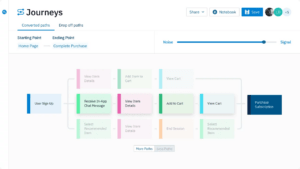
- Define and track the specific goals and objectives that your users want to achieve with your product. Analyze whether they are successfully reaching those milestones.
By implementing these strategies, you can develop a deep understanding of your users, align your product with their needs, and ensure that you meet or exceed their expectations, boosting your product adoption.
3. Create Personalized Experiences
According to Accenture, 91% of consumers are more likely to shop with brands that provide relevant offers and recommendations.
91% is a big number, right?
It highlights the importance of creating personalized experiences for your customers. This is particularly essential for improving product adoption because it acknowledges that not all users are the same and that their needs and preferences vary. This allows product owners and product managers to create a product that addresses the pain points of different customers.
Here’s how you can create personalized experiences:
- Craft personalized content and marketing campaigns that address the specific needs and pain points of each user segment. For example, create content for marketing managers that focuses on how your product can improve their marketing campaigns. For sales directors, emphasize how it can boost their sales performance.
- Create distinct onboarding paths for different user personas. A good onboarding tool will allow you to tailor the initial setup and tutorials to your customer’s specific goals. Provide content and guidance that aligns with their objectives.
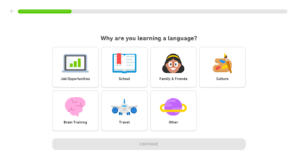
For example, while creating an account in Duolingo, users are asked to answer certain questions during the onboarding process. This allows Duoloingo to understand their customers’ goals and create a personalized onboarding experience for their customers.
- Develop subscription plans that cater to different user profiles. For example, offer “Basic,” “Pro,” and “Premium” plans. Each plan should align with the needs and budgets of different segments.
- Different user segments may have different preferences for how they seek assistance. So, provide multiple support channels, such as live chat, email, and phone support.
By focusing on personalized experiences, you can enhance user engagement, satisfaction, and ultimately, product adoption. Users are more likely to stick with and fully adopt a product that caters to their unique needs and provides a seamless and tailored experience.
4. Design An Excellent Personalized Onboarding Process
Do you know that friction during the onboarding process can result in as much as 75% of customers opting for another provider?
This staggering number highlights the importance of creating a seamless and engaging onboarding process for first-time users. Here’s how you can do that.
- Make your onboarding process personalized. This allows you to reduce customer effort and minimizes user frustration. It helps users quickly grasp the key features and functionalities they need to achieve their goals.
- Focus on creating a short and value-based onboarding. Don’t overwhelm your users with different features and functionalities. Focus on the features that align with your user’s goals and needs.
- Incorporate guided walkthroughs, tutorials, help articles, FAQs, and demos to help users become familiar with the product’s interface and capabilities on their own. This allows users to resolve issues on their own and be self-reliant.
Tip: Take feedback from your customers with onboarding surveys to optimize your process further!
By implementing personalized, short, and value-focused onboarding processes that incorporate various learning resources you can enhance the user experience and improve product adoption.
Create an effective onboarding process with onboarding surveys! Sign up today!
5. Drive Feature Adoption
Let’s say you have a fitness app. You have now upgraded your user interface design and want your users to update the app to experience the new changes. How to notify them without disrupting their interaction with your app?
Here’s how:
- Use in-app messaging like nudges to highlight key features. Make sure not to disrupt your user’s interaction with your app. Don’t bombard them with notifications, just gently make them aware of the update.

For example, Google Chrome notifies its users of new updates subtly by flashing new update notifications in the upper right corner of the screen. Users just have to click on the notification and Chrome will be updated.However, be mindful of Chrome CPU usage, especially if you notice Google Chrome Helper eating CPU resources. Monitoring and optimizing your browser can help manage CPU usage for a smoother and more efficient browsing experience.
- Leverage analytics tools like Mixpanel, BI, Amplitude, or Segment to track user behavior within your app. These tools can help identify which features users are struggling to adopt.
- Update the user interface to make new features more prominent. This could involve redesigning menus, adding feature shortcuts, or highlighting new functionalities on the dashboard.
- After users have been exposed to the new features and nudges, consider sending out feature adoption surveys. This will allow you to gauge the effectiveness of your in-app messages and notifications.

By focusing on these personalized strategies, you can cater to the unique needs and preferences of both decision-makers and product users, making it more likely that they will adopt your product effectively and find value in it.
6. Remove Any Potential Barriers to Adoption
Let’s say you have launched a new feature in your beauty app that enables users to filter beauty products by brands. But not many users are using it. It can be because the navigation is complex or the feature is hard to find. Now with thousands of users, how will you be able to find and fix the issue?
Here’s how you can do it:
- Track your DAU and MAU metrics. These metrics will help you to understand how frequently users are interacting with your product, helping you gauge its overall adoption and popularity.
- Leverage session recording tools like Windows Clarity that will you track your user journey and identify any barriers and drop-offs.
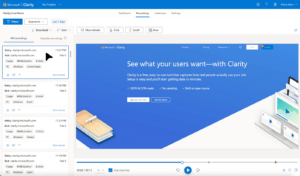
- Offer a free trial for new features or apps. This will allow users to engage and experience your app without any commitments and give their honest feedback.
- Ensure compatibility across all browsers and devices. In addition to digital strategies, incorporating targeted cold calling campaigns can also be effective in reaching potential users and addressing their specific needs, thereby contributing to improved product adoption rates
7. Incentivize Adoption
Incentivizing your users during the product adoption journey can be a crucial step in attracting and retaining customers. Here’s how you can do it:
- Reward users who reach specific adoption milestones. For example, offer a discount or a free upgrade to customers who have been using your product for a certain period. This encourages both initial adoption and continued usage.

For example, the Advantage program by American Airlines rewards frequent flyers with miles that can be redeemed for free flights, seat upgrades, and other travel-related benefits.
- Implement a loyalty program where existing customers can earn rewards for referring new users to your product. This leverages the power of word-of-mouth marketing and encourages your customers to become advocates for your brand.
- Collaborate with influencers who align with your product’s target audience. Influencers can authentically promote your product to their followers, showcasing its value and benefits.
Make sure to prevent any loss of your precious time and money and measure the effectiveness of your loyalty program with CSAT surveys.
8. Offer Exceptional Customer Support
Customer support is the cornerstone of creating an exceptional customer experience for any business. It’s the most basic thing customers expect from any business they deal with.
In fact, according to a survey by Forrester, 41% of customers expect a response to a customer support email within 6 hours but only 36% of the businesses are able to respond within the timeframe.
This shows that selling products is not enough, you have to be there for your customers at every step of the way. This will ensure that your customers feel valued and heard and find value in your product.
So, here’s how you can ensure that your customer support is top-notch:
- Instead of being reactive train your customer support staff to be proactive. For example, if a customer buys a phone from you, call them to check if everything is okay and also inform them about other offers that will complement their phone.
- 81% of customers intend to take care of matters by themselves before reaching out to a customer service representative. So, employ self-service options in your customer service to enhance customer experience and reduce customer effort.
- Assign dedicated Customer Success Managers to important accounts or high-value customers. CSMs should guide users through their journey, ensuring they understand the product, its features, and how to derive maximum value from it.
- Create a balance between self-help options and human support. Give customers the option to resolve small issues like refund, return, etc. by themselves but also provide them with the option of reaching out to you through an IVR system in case of bigger issues.
- Utilize analytics to track at-risk behaviors and usage patterns that may indicate a customer is in danger of churning. Develop strategies to reach out to these customers with targeted support and solutions to prevent churn.
- Implement support surveys to gather insights into the quality of support provided and areas for improvement. Act on this feedback to enhance your support services continually.
Remember that exceptional customer support can set your business apart from competitors and lead to long-term customer loyalty.
9. Set up KPIs to Measure Product Adoption
Setting up SaaS KPIs to measure and improve product adoption is crucial for assessing the success of your product and understanding how well it is being embraced by your target audience. Here are three important KPIs to track:
- Product Adoption Rate: It measures the percentage of your target users who have started using your product within a specific time frame. Monitoring this KPI helps you gauge the overall appeal and success of your product within your target market.
- Conversion Rate: It measures the percentage of users who take a specific desired action, such as signing up for your product, etc. It helps you evaluate the effectiveness of your onboarding processes, user interface, and call to action.
- Time to Value: It measures the amount of time it takes for a new user to derive meaningful value from your product. Tracking TTV helps identify bottlenecks in onboarding or user education.
Remember that the choice of KPIs should align with your specific product goals and business objectives. Regularly track and analyze these metrics to make data-driven decisions, refine your product adoption strategies, and ultimately enhance the success of your product in the market.
10. Create an Irreplaceable SaaS Product
It goes without saying that the SaaS product you create should aim at solving users’ pain points and hence become irreplaceable for them. Making your product irreplaceable is also required for sustainable growth and customer retention. Here are key strategies to achieve this:
- Ensure that your product is easy to onboard, access, and use. A user-friendly interface and intuitive design are critical for reducing barriers to entry.
- Embrace the concept of “less-code” or “no-code” adoption, which allows users to start using your product without extensive technical expertise.
- Integrate your SaaS product with as many relevant tools and platforms as possible. This makes your product an indispensable part of your customers’ tech ecosystem.
- Consider leveraging native cloud-based app integrations and APIs to connect seamlessly with other software solutions your customers rely on.
- Provide impeccable customer support. Exceptional customer service can set you apart from competitors and create a strong emotional connection with your users.
- Continuously enhance your product based on user feedback and evolving market needs. Regular updates and feature enhancements demonstrate your commitment to delivering value to your customers.
By focusing on these strategies, you can make your SaaS product an indispensable part of your customers’ operations, increasing user retention, and building a loyal customer base.
11. Go One Step Beyond Regular Updates
Going one step beyond regular updates is an excellent approach to not only retain your SaaS customers but also turn them into enthusiastic advocates for your product. Here are some strategies to take your updates to the next level:
- Ensure that each update addresses pain points or adds functionality that enhances the user experience. Consider conducting user surveys or gathering feedback to understand what features or improvements your customers prioritize.
- Gamify your SaaS platform by introducing elements like achievements, badges, leaderboards, or progress tracking. This taps into users’ psychological motivations for competition and achievement, making the product more engaging.
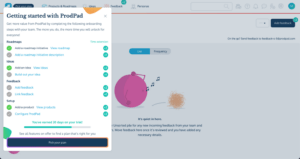
For example, ProdPad, a project management platform, provides first-time users with a checklist to set up an account on the platform. The checklist tells the user which tasks are done and what is left.
- Engage your user base in the product development process. Conduct feature prioritization surveys to understand which enhancements are most critical to your users.
- Ensure proactive communication with your customers by:
- Sending daily digests or weekly newsletters highlighting notable changes and how they benefit users.
- Implementing chatbots and automated workflows to congratulate users on their achievements within the product. For example, when a user completes a significant task congratulate them with an automated message.
- Passing high-value them through to a CSM who can build a more intimate relationship and provide personalized attention.
- Offering ongoing webinars to help users make the most of your product’s new features and updates.
By adopting these strategies, you can go beyond regular updates and create a user experience that is not only valuable but also engaging and personally rewarding.
Conclusion
Creating and selling your SaaS product is not enough, your customers need to find value in your product that’s when your product becomes irreplaceable. This is why along with improving the UX and UI of SaaS products, businesses also need to focus on improving their product adoption.
With the 11 proven strategies provided in the blog, product managers can seamlessly improve their product adoption, retain customers, and boost their growth.
Now, to improve your product adoption, you also need to listen to the voice of your customers. This is where SurveySensum comes onto the field. It can help you create, send, track, and analyze thousands of feedback which will enable you to take action and resolve issues in real time.
Don’t let low product adoption and customer churn weigh you down. SurveySensum’s SaaS customer feedback platform bridges the gap between you and your users.
FAQ
The customer adoption process refers to the series of stages that a customer or user goes through when they start using a new product or service. It outlines the journey from the initial awareness of the product to becoming a regular and satisfied user.
Product Adoption Rate is a key metric used by companies to measure the percentage of their users or customers who have adopted and are actively using a specific product or feature within a given time period.
A product adoption strategy is a structured plan that a company or organization develops to encourage and facilitate the successful uptake and usage of its products or services by its target audience. The goal of a product adoption strategy is to ensure that users not only become aware of a product but also embrace it, use it effectively, and continue to derive value from it over time.
The answer to how to Improve product adoption is by ensuring it meets users’ needs, offering a seamless onboarding process, providing comprehensive support and training, gathering and acting on user feedback, and continuously enhancing the product based on user insights.
Improve user adoption by simplifying the user interface, providing step-by-step onboarding guides, ensuring excellent customer support, integrating user feedback into product updates, and creating a user community for shared learning and support.
Product adoption refers to the process by which customers start using and integrating a new product into their regular activities, transitioning from initial awareness to consistent and sustained usage.
To increase product adoption:
- Enhance Onboarding: Provide a seamless and intuitive onboarding process.
- Offer Training and Support: Provide comprehensive user guides, tutorials, and responsive customer support.
- Gather and Act on Feedback: Collect user feedback and make continuous improvements based on their insights.
- Simplify User Experience: Ensure the product is easy to use with a clear, intuitive interface.
- Free Trials and Demos: Offer free trials or demos to allow potential users to experience the product’s value firsthand.






